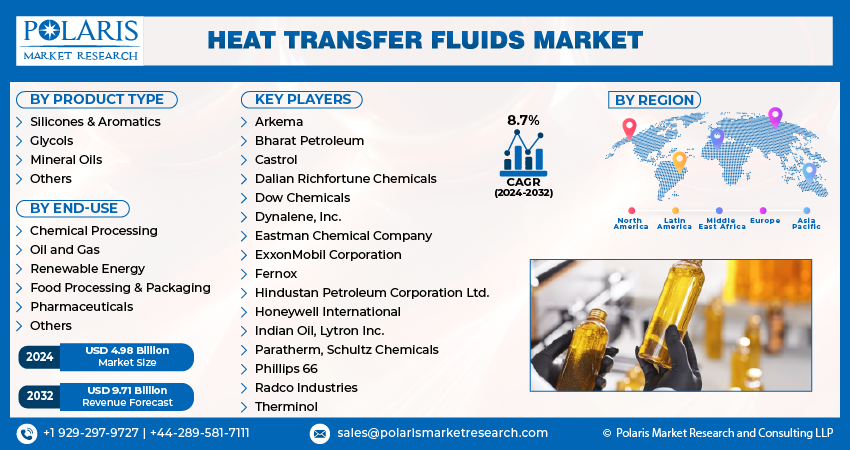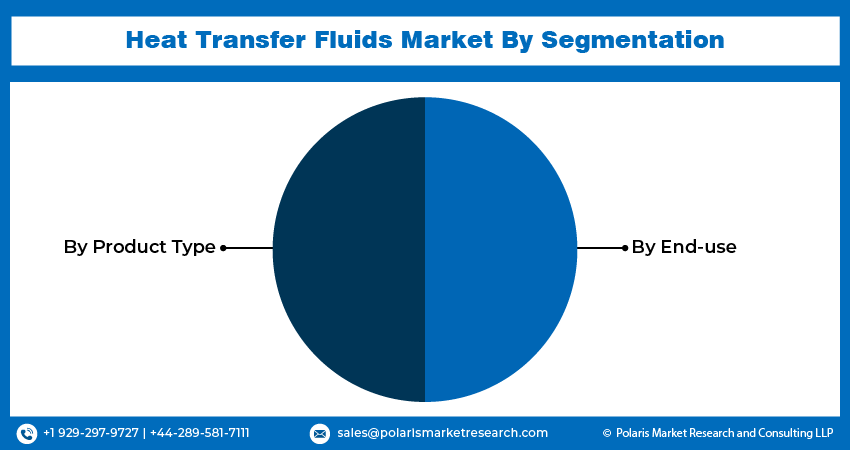
Heat Transfer Fluids Market Share, Size, Trends, & Industry Analysis Report By Product Type (Silicones & Aromatics, Glycols, Mineral Oils, Others); By End-Use; By Region, Segment Forecasts, 2024 - 2032
- Published Date:Feb-2024
- Pages: 119
- Format: PDF
- Report ID: PM1124
- Base Year: 2023
- Historical Data: 2019-2022
Report Outlook
The global heat transfer fluids market size and share is projected to witness robust growth. It was valued at USD 4.60 billion in 2023 and is projected to grow to USD 9.71 billion by 2032, exhibiting a CAGR of 8.7% over the forecast period, 2024 - 2032
The eutectic mixtures that comprise heat transfer fluids are composed of two stable components. To handle the mixture or composition as a single compound, these products essentially have the same vapor pressure. These kinds of fluids are mainly utilized in systems that use heating in the liquid-vapor phase. Its typical use ranges from 60°F to 750°F (15°C to 400°C), with an ambient pressure range of 152.5 psi (10.6 bar). At elevated temperatures, these products exhibit stability and rapidly do not decompose. These liquids work well in systems with either a liquid phase or a vapor phase. Their consistent low viscosity across the whole working range finally leads to an effective heat transfer. These fluids do not corrode the typical alloys and metals; thus, the demand is anticipated to increase due to the qualities of these items.
A liquid or a gas that converts heat from one constituent to another is known as heat transfer fluid. These fluids are utilized in the procedure where cooling or warming is needed to acquire and sustain a specific temperature. The allocation that is advisable in heat transfer fluids are consistency when the temperature is low, excessive thermal potential and particular heat, eco-friendliness, minimum or nontoxicity, escalated flash point, and economical.
In the plastic industry, heat transfer fluids are required for polycondensation and polymerization of polyester, clarifying nylon, making man-made fibers, and PET molding functions. Heat transfer fluids are also crucial for an aggregate of chemical manufacturing procedures involving phthalic anhydride (PA), linear alkyl benzene (LAB), dimethyl terephthalate (DMT), plasticizers, spirits, olefins, and many other petrochemicals. The heat transfer fluids market demand is on the rise as they have many benefits in varying freezing and defrosting applications. Wineries, fruit processors, and dairies can utilize these fluids to maintain the cool of products while processing.

To Understand More About this Research: Request a Free Sample Report
There is increasing demand from diverse end-use industries such as chemical, oil and gas, manufacturing, and solar power. The rising need for efficient heat transfer solutions in industrial processes, coupled with the emphasis on energy efficiency, has propelled the adoption of advanced heat transfer fluids.
- For instance, the Department of Chemical Engineering, IIT Guwahati, produced a novel heat transfer fluid based on nanofluids, which can efficiently transfer heat generated using solar power to desalination systems.
Along with this, the growing focus on renewable energy sources has fueled the demand for heat transfer fluids in concentrated solar power plants and geothermal applications. The market has also witnessed innovations in fluid formulations, including bio-based and synthetic heat transfer fluids, contributing to environmental safety.
Despite this, several factors affected the market growth, such as fluctuating raw material prices, regulatory challenges associated with the use of certain types of heat transfer fluids, and the high initial cost of installation and maintenance. In addition, the impact of the COVID-19 pandemic on global supply chains and economic uncertainties has influenced the market dynamics.
The research study provides a comprehensive analysis of the industry, assessing the market based on various segments and sub-segments. It sheds light on the competitive landscape and introduces heat transfer fluids Market key players from the perspective of market share, concentration ratio, etc. The study is a vital resource for understanding the growth drivers, opportunities, and challenges in the industry.

Industry Dynamics
Growth Drivers
The rapid industrialization and supportive renewable energy policies fuel the demand for heat transfer fluids.
As industries around the world undergo significant expansion and technological advancements, there is an increased demand for efficient and sustainable heat transfer solutions. Heat transfer fluids play an important role in various industrial processes, ensuring the effective transfer of thermal energy and contributing to the overall efficiency of operations.
The adoption of these fluids is further accelerated by governmental initiatives promoting the use of renewable energy sources. Supportive policies, such as incentives and subsidies for renewable energy projects, have incentivized industries to integrate heat transfer fluids into their operations, particularly in concentrated solar power plants and other renewable energy applications. The emphasis on reducing carbon footprints and transitioning towards cleaner energy alternatives has further increased the significance of heat transfer fluids in the global market.
As industries seek to comply with stringent environmental regulations and meet sustainability goals, the demand for innovative and eco-friendly heat transfer fluids, including bio-based and synthetic variants, is on the rise. Owing to these factors, the market is growing and will continue to grow in the forecast period.
Report Segmentation
The market is primarily segmented based on product type, end-user, and region.
|
By Product Type |
By End-use |
By Region |
|
|
|
To Understand the Scope of this Report: Speak to Analyst
By Product Type Analysis
Glycol-based heat transfer fluids led the market in 2023.
In 2023, glycol-based heat transfer fluids emerged as the leading choice in the heat transfer fluids market for several reasons, as glycol-based fluids, specifically ethylene and propylene glycols, have gained prominence due to their excellent thermal properties and stability across a wide range of applications. These fluids exhibit high thermal conductivity, ensuring efficient heat transfer in various industrial processes.
Also, glycol-based heat transfer fluids possess unique temperature stability, allowing them to operate effectively across both high and low temperatures. The factor driving the dominance of glycol-based fluids is their ability to prevent freezing and corrosion, making them particularly well-suited for applications in cold climates and various industrial establishments. This characteristic enhances the reliability and longevity of the systems in which they are employed. Along with this, glycol-based fluids are known for their low toxicity compared to other alternatives, contributing to their widespread acceptance in industries where safety and environmental considerations are important. As industries continue to seek reliable and efficient heat transfer solutions, glycol-based fluids are likely to maintain their dominance in the global market.
By End-use Analysis
Oil and Gas segment dominated the market in 2023
In the oil and gas industry, heat transfer fluids play an important role in various processes, including exploration, extraction, refining, and transportation. These fluids are utilized in applications such as heating, cooling, and maintaining optimal temperatures in equipment and pipelines. The dominance of the oil and gas segment is further fueled by the global dependence on fossil fuels, driving increased activities and investments in this sector. The continuous expansion of oil and gas exploration and production activities, coupled with the increasing extraction techniques, has led to a growing dependence on advanced heat transfer fluids to ensure the reliability and efficiency of important equipment. Along with this, as the industry faces increased environmental safety, there is a growing emphasis on adopting heat transfer fluids that align with sustainability goals, further contributing to market growth.

Regional Insights
Asia Pacific region accounted for the largest market share in 2023
The Asia Pacific region emerged as the dominant region, accounting for the largest market share in the heat transfer fluids market in 2023, and this dominance is due to the factors driving industrialization, infrastructure development, and the adoption of advanced technologies in the region. As countries in the Asia Pacific continue to experience rapid economic growth, there is a rising demand for energy across various industries, ranging from manufacturing and construction to automotive and electronics. This increased industrial activity has propelled the need for efficient heat transfer solutions, positioning heat transfer fluids as integral components in several applications.
Also, supportive government policies and investments in renewable energy projects have further propelled the adoption of heat transfer fluids, particularly in solar power generation, which is gaining traction in the region. The Asia Pacific region has been visionary in implementing sustainable practices and technologies to address environmental concerns, making heat transfer fluids crucial for enhancing energy efficiency in industrial processes.
North America is predicted to grow at a significant CAGR over the forecast period due to increased energy released during processes and growing demand to develop excess warmth in important industries like concentrated solar power plants, chemicals, and HVAC (Heating, Ventilation, and Air Conditioning). The market for heat transfer fluids is expanding due to the chemical processing industries.

Key Market Players & Competitive Insights
The heat transfer fluids market exhibits a diverse landscape, with several key players contributing to its dynamic growth. Established industry participants such as Dow Chemicals, Eastman Chemical Company, and ExxonMobil Corporation continue to have a significant influence, offering their extensive product portfolios and global presence. These market leaders are actively engaged in research and development efforts to introduce advanced formulations, catering to the evolving demands for improved thermal performance and environmental sustainability.
Some of the major players operating in the global heat transfer fluids market include:
- Arkema
- Bharat Petroleum
- Castrol
- Dalian Richfortune Chemicals
- Dow Chemicals
- Dynalene, Inc.
- Eastman Chemical Company
- ExxonMobil Corporation
- Fernox
- Hindustan Petroleum Corporation Ltd.
- Honeywell International
- Indian Oil
- Lytron Inc.
- Paratherm, Schultz Chemicals
- Phillips 66
- Radco Industries
- Therminol
Recent Developments
- In July 2021, Castrol, an Oil and Gas company, launched a new Castrol ON e-thermal fluid formulated specifically for direct cooling.
- In November 2022, Fernox Ltd., a chemical manufacturing company, launched a Heat Transfer Fluid, HP EG, which is based on ethylene glycol for air and ground source heat pump systems.
Heat Transfer Fluids Market Report Scope
|
Report Attributes |
Details |
|
The market size value in 2024 |
USD 4.98 billion |
|
Revenue Forecast in 2032 |
USD 9.71 billion |
|
CAGR |
8.7% from 2024 – 2032 |
|
Base year |
2023 |
|
Historical data |
2019 – 2022 |
|
Forecast period |
2024 – 2032 |
|
Quantitative units |
Revenue in USD billion and CAGR from 2024 to 2032 |
|
Segments Covered |
By Product Type, By End-use, and By Region |
|
Regional scope |
North America, Europe, Asia Pacific, Latin America; Middle East & Africa |
|
Customization |
Report customization as per your requirements concerning countries, regions, and segmentation. |
Explore the market dynamics of the 2024 heat transfer fluids market share, size, and revenue growth rate, meticulously examined in the insightful reports crafted by Polaris Market Research Industry Reports. The analysis of the Heat Transfer Fluids Market extends to a comprehensive market forecast up to 2032, coupled with a retrospective examination. Avail yourself of a complimentary PDF download to sample this in-depth industry analysis.
Browse Our More Top Selling Reports:
Data Center Market Size & Share
Green Data Center Market Size & Share
Respiratory Care Devices Market Size & Share
FAQ's
Arkema, Bharat Petroleum, Castrol, Dalian Richfortune Chemicals, Dow Chemicals, Dynalene, Inc., Eastman Chemical Company, ExxonMobil Corporation, Fernox, are the key companies in Heat Transfer Fluids Market
The global heat transfer fluids market is projected to grow at a CAGR of 8.7% during the forecast period.
The Heat Transfer Fluids Market report covering key segments are product type, end-user, and region.
The rapid industrialization and supportive renewable energy policies fuel the demand for heat transfer fluids are the key driving factors in Heat Transfer Fluids Market
The global heat transfer fluids market size is expected to reach USD 9.71 billion by 2032

